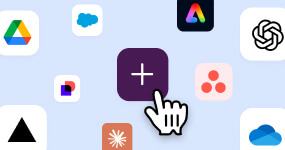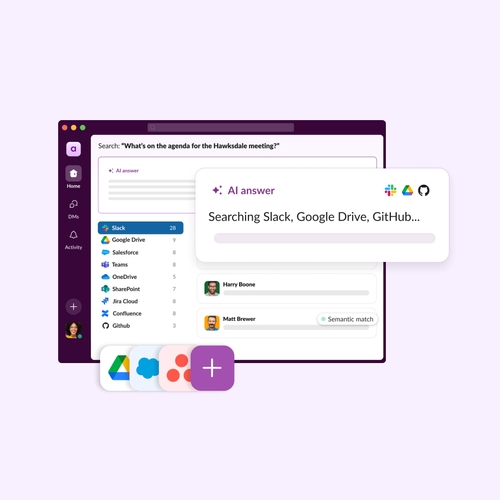As we covered in our earlier post on Microsoft’s Teams unbundling, organizations now have the freedom to rethink their tools. But with that choice comes a critical question: can your AI reach its full potential if your tools aren’t connected?
Without a unified platform to provide connected context across conversations, files, apps, and workflows, your AI can only see half the story. Critical business knowledge remains siloed, decisions slow down, and opportunities slip through the cracks. This is the hidden risk of disconnected tools for work and why building on a platform like Slack can help businesses move beyond incremental efficiency and unlock truly transformative productivity.
Modern work requires a connected foundation
For decades, productivity was defined by disconnected apps. People had to fill the gaps through constant context-switching between emails, documents, spreadsheets, and meetings. But AI can’t improvise the way humans can. To act like a true digital teammate, it needs access to shared context across people, data, and tools.
Slack was built for this new era of connected, intelligent work. It’s an open, unified platform where communication, collaboration, and automation happen in real time. The best part? Slack scales effortlessly with your business as new teams, tools, and AI agents join the mix. Every conversation, decision, and document lives where work actually happens, making this context transparent, searchable, and actionable.
Unlike disconnected apps, Slack ensures that neither your people nor your AI operate in silos. By connecting your entire technology ecosystem — from Microsoft 365 and Salesforce to your custom internal tools — Slack provides the foundation for smarter insights, faster decisions, and more coordinated execution across your organization.
This is modern work powered by connected intelligence. Innovative, AI-first companies like IBM, Target, Rivian, and CapitalOne use Slack as the foundation for how they work. They’re choosing platforms that scale how people think, move, and build.
How Slack is fundamentally different
Slack has moved far beyond a collaboration tool; it’s an agentic operating system built to run your entire business. As a truly open work platform, Slack, the Searchable Log of All Conversationsand Knowledge, was designed to unite structured and unstructured context in real time. This empowers your AI and agents to understand, act, and collaborate alongside people.
Here’s what that looks like in practice:
Work becomes transparent
In Slack, collaboration doesn’t follow your org chart. Slack channels organize around projects like feature launches, sales deals, or incident responses. You can start in direct messages (DMs), expand to a group naturally, then turn that collaboration into a channel without losing valuable prior context. Unlike Slack, Teams’ rigid channel structure tends to push cross-functional work back into email chains and external tools.
Automation is simple and accessible to all
Millions use Workflow Builder every week to eliminate repetitive tasks, no developer skills required. These automations connect directly into the systems and data teams use most, creating compounding productivity gains. In Teams, even simple automation needs Power Automate expertise, creating IT bottlenecks for basic improvements. Your team could wait weeks for what should take minutes.
AI is native to the flow of work
AI in Slack is deeply embedded across workflows, surfacing instant answers and insights grounded in your company’s context and drawing from conversations, files, and updates rather than generic web data. Ask Slackbot to “summarize yesterday’s client call and highlight next steps,” and it analyzes the call transcript and relevant channel discussions. Ask for a project status update, and AI pulls from engineering updates, design reviews, and stakeholder feedback across multiple channels. Try asking Copilot to connect insights from a Teams call with related SharePoint documents and Outlook emails; you’ll quickly hit the limits of fragmented data.
AI capabilities are included in every paid Slack plan.
Connect your entire tech stack seamlessly
With 2,600-plus integrations, Slack links your entire tech ecosystem, so your teams and your AI can operate from the same shared source of truth. Plus, Slack works with the AI tools you actually want to use. Whether that’s ChatGPT, Claude, or Google Agentspace, they all integrate seamlessly into Slack. You pick the best tools for your team and use them all in the platform where teams already collaborate.
This is what separates a chat tool from a work platform.
A turning point for every organization
The unbundling of Teams marks the end of packaged productivity and the beginning of something new. It’s a signal that the market is moving toward openness, interoperability, and choice. Learn how leading enterprises are achieving productivity gains and preparing for an AI-first future with Slack.
Want to learn more about switching from Teams to Slack?
- Sign up for our live webinar, “How Slack Unlocks Your Team’s Full Potential” on Nov. 18th at 11 a.m. PT
- Find the right plan for your team
- Talk to Sales to learn more and get access






